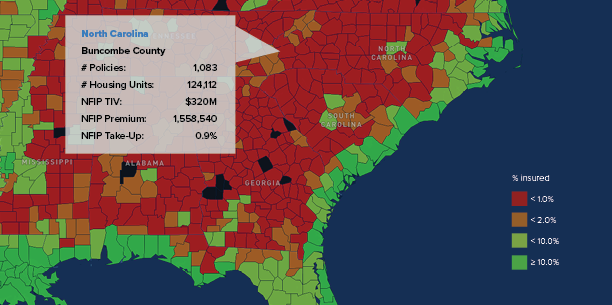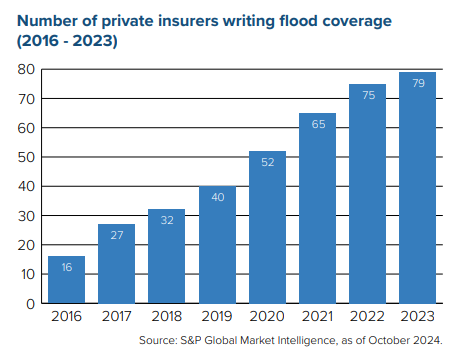The devastation wrought by Hurricane Helene in September 2024 throughout a 500-mile swath of the U.S. Southeast highlighted the rising vulnerability of inland areas to flooding from each tropical storms and extreme convective storms, in line with the newest Triple-I “State of the Threat” Points Temporary.
These occasions additionally spotlight the dimensions of the flood-protection hole in non-coastal areas. Personal insurers are stepping as much as assist shut that hole, however elevated home-owner consciousness and funding in flood resilience throughout all co-beneficiary teams shall be wanted as increasingly individuals transfer into hurt’s means.
Helene dumped 40 trillion gallons of water throughout Florida, Georgia, the Carolinas, Virginia, and Tennessee, inflicting a whole bunch of deaths and billions in insured losses. A lot of the loss was concentrated in western North Carolina, with elements of Buncombe County – residence to Asheville and its historic arts district – left just about unrecognizable. Lower than 1 p.c of residents in Buncombe County had federal flood insurance coverage when Helene struck.

The expertise of those states far inland echoed these of New York, New Jersey, and Pennsylvania in August 2021, when remnants of Hurricane Ida introduced rains that flooded subways and basement flats, with greater than 40 individuals killed in these states.
“The entire swath going up the East Coast” that Hurricane Ida struck within the days after it made landfall “had lower than 5 p.c flood insurance coverage protection,” stated Triple-I CEO Sean Kevelighan on the time.
Then, in July 2023, a sequence of intense thunderstorms resulted in heavy rainfall, lethal flash floods, and extreme river flooding in japanese Kentucky and central Appalachia. Flooding led to 39 fatalities and federal disaster-area declarations for 13 japanese Kentucky counties. In accordance with the Federal Emergency Administration Company (FEMA), just a few dozen federal flood insurance coverage insurance policies had been in impact within the affected areas earlier than the storm.
Low inland take-up charges largely mirror shopper misunderstandings about flood insurance coverage. Although roughly 90 p.c of all U.S. pure disasters contain flooding, many householders are unaware that an ordinary householders coverage doesn’t cowl flood injury. Equally, many consider flood protection is pointless until their mortgage lenders require it. It additionally just isn’t unusual for householders to drop flood insurance coverage protection as soon as their mortgage is paid off to save cash.
Personal insurers stepping up
Greater than half of all householders with flood insurance coverage are coated by NFIP, which is a part of FEMA and was created in 1968 – a time when few non-public insurers had been keen to write down flood protection. Lately, nevertheless, insurers have grown extra snug taking up flood threat, thanks largely to improved information and analytics capabilities.
The non-public flood market has modified since 2016, when solely 12.6 p.c of protection was written by 16 insurers. In 2019, federal regulators allowed mortgage lenders to simply accept non-public flood insurance coverage if the insurance policies abided by regulatory definitions. The already-growing non-public urge for food for flood threat gained steam after that. Personal insurers are steadily accounting for an even bigger piece of a rising flood threat pie.

Insurance coverage obligatory – however not ample
Insurance coverage can play a serious position in closing the safety hole, however, with rising numbers of individuals transferring into hurt’s means and storms behaving extra unpredictably, the present state of affairs just isn’t sustainable. Better funding in mitigation and resilience is important to lowering the non-public and monetary losses related to flooding.
Such investment has paid off in Florida, the place the communities of Babcock Ranch and Hunters Level survived Hurricanes Helene and Milton comparatively unscathed. Babcock Rance made headlines for sheltering 1000’s of evacuees from neighboring communities and by no means dropping energy throughout Milton, which devastated quite a few neighboring cities and left greater than three million individuals with out energy.
Each of those communities had been designed and constructed lately with sustainability and resilience in thoughts.
Incentives and public-private partnership shall be crucial to lowering perils and enhancing insurability in susceptible places. Current analysis on the affect of eradicating growth incentives from coastal areas can enhance flood loss expertise within the areas straight affected by the removing of such incentives, in addition to neighboring areas the place growth subsidies stay in place.
Study Extra:
Government Trade: Utilizing Superior Instruments to Drill Into Flood Threat
Precisely Writing Flood Protection Hinges on Numerous Information Sources
Lee County, Fla., Cities May Lose NFIP Flood Insurance coverage Reductions
Miami-Dade, Fla., Sees Flood-Insurance coverage Fee Cuts, Because of Resilience Funding
Milwaukee District Eyes Increasing Nature-Primarily based Flood-Mitigation Plan
Attacking the Threat Disaster: Roadmap to Funding in Flood Resilience

